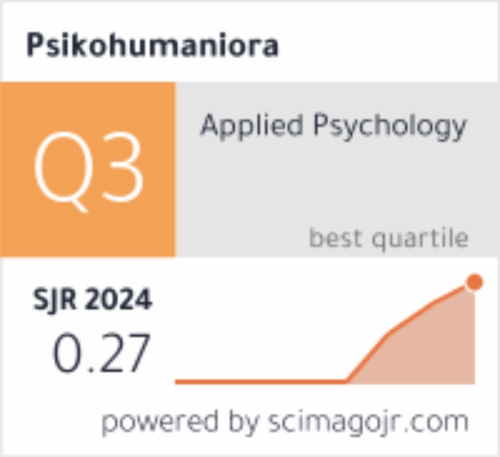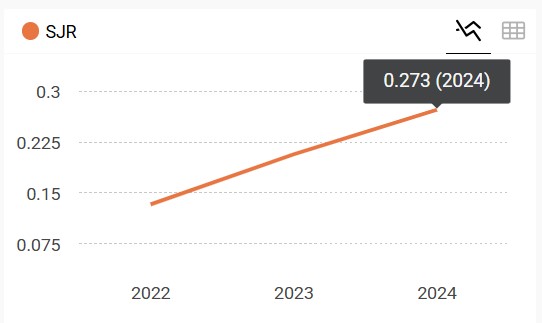How do they deal with the Pandemic? The effect of secure attachment and mindfulness on adolescent resilience
DOI:
https://doi.org/10.21580/pjpp.v6i1.6857Keywords:
secure attachment, mindfulness, adolescent resilienceAbstract
Building resilience in adolescents is an important need, especially for those who spend most of their time at home with their families while facing the pandemic situation. Resilience enables adolescents to survive, adapt, and rise up when faced with difficult circumstances. This study aims to empirically examine the role of secure attachment and mindfulness in adolescent resilience in the new normal era. The study subjects were 220 junior high school students in Semarang City, Indonesia, who were selected using the convenience sampling technique. The study is based on correlational quantitative research using regression analysis. The instruments used were the Secure Attachment Scale, Mindfulness Scale, and Resilience Scale. The results show that there was a significant and positive relationship between secure attachment and mindfulness, and adolescent resilience in the new normal era (R2 = .56, F = 16169, p < .01). The findings provide useful suggestions for families to emphasize the development of psychological skills, especially resilience in adolescents, throughout the country.
Downloads
References
Ainsworth, M. D. S. (1978). Patterns of attachment: A psychological study of the strange situation. Lawrence Erlbaum Associates.
Anapratiwi, D., Handayani, S. S. D., & Kurniawati, Y. (2013). Hubungan antara kelekatan anak pada ibu dengan kemampuan sosialisasi anak usia 4-5 tahun (Studi pada RA Sinar Pelangi dan RA Al Iman Kecamatan Gunungpati, Semarang). Early Childhood Education Papers (Belia), 2(1), 23–30. https://doi.org/10.15294/BELIA.V2I1.2243
Arif, I. S. (2016). Psikologi positif: Pendekatan saintifik menuju kebahagiaan. Gramedia Pustaka Utama.
Aryanti, Z. (2015). Kelekatan dalam perkembangan anak. Jurnal Tarbawiyah, 12(2), 245–258.
Asmariza, W., Chairilsyah, D., & Puspitasari, E. (2019). Hubungan kelekatan aman (secure attachment) dengan resiliensi anak usia 5-6 tahun di TK Negeri Pembina 3 Kecamatan Marpoyan Damai Kota Pekanbaru. Jurnal Online Mahasiswa Fakultas Keguruan Dan Ilmu Pendidikan, 6(2).
Azzahra, F. (2017). Pengaruh resiliensi terhadap distres psikologis pada mahasiswa. Jurnal Ilmiah Psikologi Terapan, 5(1), 80–96. https://doi.org/10.22219/jipt.v5i1.3883
Baer, R. A., Smith, G. T., Hopkins, J., Krietemeyer, J., & Toney, L. (2006). Using self-report assessment methods to explore facets of mindfulness. Assessment, 13(1), 27–45. https://doi.org/
1177/1073191105283504
Baer, R. A., Smith, G. T., Lykins, E., Button, D., Krietemeyer, J., Sauer, S., Walsh, E., Duggan, D., & Williams, J. M. G. (2008). Construct validity of the Five Facet Mindfulness Questionnaire in meditating and nonmeditating samples. Assessment, 15(3), 329–342. https://doi.org/10.1177/
Bowlby, J. (1988). A secure base: Parent-child attachment and healthy human development. Basic Books.
Brown, K. W., & Ryan, R. M. (2003). The benefits of being present: Mindfulness and its role in psychological well-being. Journal of Personality and Social Psychology, 84(4), 822–848. https://doi.org/10.1037/0022-3514.84.4.822
Brown, K. W., Ryan, R. M., & Creswell, J. D. (2007). Mindfulness: Theoretical foundations and evidence for its salutary effects. Psychological Inquiry, 18(4), 211–237. https://doi.org/10.1080/10478400701598298
Bukhori, B., Hassan, Z., Hadjar, I., & Hidayah, R. (2017). The effect of sprituality and social support from the family toward final semester university students’ resilience. Man in India, 97(19), 313–321.
Cassidy, J., & Shaver, P. R. (2017). Handbook of attachment: Theory, research, and clinical applications. Guilford Press.
Fourianalistyawati, E., Listiyandini, R. A., & Fitriana, T. S. (2016). Hubungan mindfulness dan kualitas hidup orang dewasa. Prosiding Forum Ilmiah Psikologi Indonesian (FIPI), 1–12.
Grothberg, E. (1995). A guide to promoting resilience in children: Strengthening the human spirit. Early childhood development: Practice and reflections (No. 8). Benard van Leer Foundation.
Guessoum, S. B., Lachal, J., Radjack, R., Carretier, E., Minassian, S., Benoit, L., & Moro, M. R. (2020). Adolescent psychiatric disorders during the COVID-19 pandemic and lockdown. Psychiatry Research, 291, 113264. https://doi.org/10.1016/j.psychres.2020.113264
Hague, G., & Mullender, A. (2006). Who listens? The voices of domestic violence survivors in service provision in the United Kingdom. Violence Against Women, 12(6), 568–587. https://doi.org/10.1177/1077801206289132
Hasanudin, R. J. B., Siswandi, A. G. P., & Wardhani, N. (2019). Mindfulness-Based Cognitive Therapy (MBCT) in improving quality of life: Case study in Chronic Kidney Disease patients with hemodialysis. Psikohumaniora: Jurnal Penelitian Psikologi, 4(1), 13–26. https://doi.org/10.21580/pjpp.v4i1.3332
Henderson, N., & Milstein, M. M. (2003). Resiliency in schools: Making it happen for students and educators. Corwin Press.
Holmes, J. (1993). John Bowlby and attachment theory. Routledge.
Indirasari, D. T., Purba, D. E., & Anindita, R. (2019). Future time perspective and turnover intention: The mediating role of resilience. Psikohumaniora: Jurnal Penelitian Psikologi, 4(1), 1–12. https://doi.org/10.21580/pjpp.v4i1.3120
Jain, S., Shapiro, S. L., Swanick, S., Roesch, S. C., Mills, P. J., Bell, I., & Schwartz, G. E. R. (2007). A randomized controlled trial of mindfulness meditation versus relaxation training: Effects on distress, positive states of mind, rumination, and distraction. Annals of Behavioral Medicine, 33(1), 11–21. https://doi.org/10.1207/s15324796abm3301_2
Kabat-Zinn, J. (2003). Mindfulness-based interventions in context: Past, present, and future. Clinical Psychology: Science and Practice, 10(2), 144–156. https://doi.org/10.1093/clipsy.bpg016
Kashdan, T. B., & Ciarrochi, J. (Eds.). (2013). Mindfulness, acceptance, and positive psychology: The seven foundations of well-being. New Harbinger Publications.
Keye, M. D., & Pidgeon, A. M. (2013). Investigation of the relationship between resilience, mindfulness, and academic self-efficacy. Open Journal of Social Sciences, 1(6), 1–4. https://doi.org/10.4236/jss.2013.16001
Langer, E. J. (2016). The power of mindful learning. Da Capo Press.
Lopez, S. J. (2009). The encyclopedia of positive psychology. In The encyclopedia of positive psychology. Blackwell Publishing.
Maentiningsih, D. (2008). Hubungan antara secure attachment dengan motivasi berprestasi pada remaja. Universitas Gunadarma.
Maharani, E. A. (2013). Pengaruh pelatihan “meditasi sadar diri” terhadap penurunan tingkat distres remaja yang mengalami kehamilan pranikah. Universitas Gadjah Mada.
Marotta, J. (2013). 50 mindful steps to self-esteem : Everyday practices for cultivating self-acceptance and self-compassion. New Harbinger Publications.
Masten, A. S., & Gewirtz, A. H. (2006). Resilience in development: The importance of early childhood. In Encyclopedia on early childhood development. Centre of excellence for early childhood development.
Neff, K., & Germer, C. (2018). The mindful self-compassion workbook: A proven way to accept yourself, build inner strength, and thrive. Guilford Publications.
Nie, Y.-G., Li, J.-B., & Vazsonyi, A. T. (2016). Self-control mediates the associations between parental attachment and prosocial behavior among Chinese adolescents. Personality and Individual Differences, 96(36), 36–39. https://doi.org/10.1016/j.paid.2016.02.077
Purnama, R. A., & Wahyuni, S. (2017). Kelekatan (attachment) pada ibu dan ayah dengan kompetensi sosial pada remaja. Jurnal Psikologi, 13(1), 30–40.
Raisa, R., & Ediati, A. (2017). The relationship between social support and resilience in inmates in Class IIA Women’s Penitentiary Semarang. Jurnal Empati, 5(3).
Reivich, K., & Shatté, A. (2002). The resilience factor: 7 essential skills for overcoming life’s inevitable obstacles. Broadway Books.
Ruswahyuningsi, M. C., & Afiatin, T. (2015). Resiliensi pada remaja Jawa. Gadjah Mada Journal of Psychology, 1(2), 96–105. https://doi.org/https://doi.org/10.22146/gamajop.7347
Santoso, S. W. (2011). Keterlibatan, keberhargaan, dan kompetensi sosial sebagai prediktor kompetisi pada remaja. Jurnal Psikologi, 38(1), 52–60. https://doi.org/10.22146/jpsi.7664
Santrock, J. W. (2003). Adolescence: Perkembangan remaja (S. B. Adelar (Trans.)). Erlangga.
Sarwono, S. (2011). Psikologi remaja. RajaGrafindo Persada.
Savitri, W. C., & Listiyandini, R. A. (2017). Mindfulness dan kesejahteraan psikologis pada remaja. Psikohumaniora: Jurnal Penelitian Psikologi, 2(1), 43. https://doi.org/10.21580/pjpp.v2i1.1323
Shaver, P. R., Mikulincer, M., & Cassidy, J. (2019). Attachment, caregiving in couple relationships, and prosocial behavior in the wider world. Current Opinion in Psychology, 25(2), 16–20. https://doi.org/https://doi.org/10.1016/j.copsyc.2018.02.009
Tanay, G., Lotan, G., & Bernstein, A. (2012). Salutary proximal processes and distal mood and anxiety vulnerability outcomes of mindfulness training: A pilot preventive intervention. Behavior Therapy, 43(3), 492–505. https://doi.org/10.1016/j.beth.2011.06.003
Utami, C. T., & Helmi, A. F. (2017). Self-efficacy dan resiliensi: Sebuah tinjauan meta-analisis. Buletin Psikologi, 25(1), 54–65. https://doi.org/10.22146/buletinpsikologi.18419
Yusuf, S. (2009). Psikologi perkembangan anak dan remaja. Remaja Rosdakarya.
Downloads
Published
How to Cite
Issue
Section
License
The copyright of the accepted article shall be assigned to the publisher of the journal. The intended copyright includes the right to publish the article in various forms (including reprints). The journal maintains the publishing rights to published articles.
In line with the license, authors and any users (readers and other researchers) are allowed to share and adapt the material only for non-commercial purposes. In addition, the material must be given appropriate credit, provided with a link to the license, and indicated if changes were made. If authors remix, transform, or build upon the material, authors must distribute their contributions under the same license as the original.



